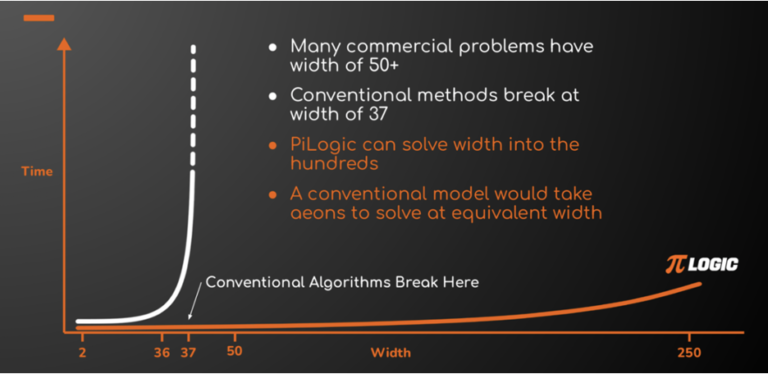Comparing PiLogic’s Treewidth Dependence with Traditional AI Models
I recently had the opportunity to speak with the founders of a company called PiLogic about their approach to a specific problem that they claim can be solved faster and with less energy consumption than Large Scale Language Models (LLMs). Their approach makes extensive use of accurate probabilistic inference, and PiLogic claims that their inference engine is the most advanced in the world when compared to Join Trees and other leading methods.
PiLogic has also submitted an application to join the International Telecommunications Union’s (ITU) Green Computing Working Group, and the company believes its techniques could be useful for many general information computing technology (ICT) applications.
The approach does not require huge datasets or expensive specialized hardware such as graphics processing units (GPUs). It is especially valuable for engineering use cases, producing accurate, precise results without hallucinations. While it is currently targeting use in aerospace and cybersecurity applications, the company believes it has the potential to become a standard AI toolkit anywhere math-based answers are needed, mistakes can be costly, and results need to conform to expert knowledge.
Use cases include (1) autonomous systems such as autonomous flight, (2) cybersecurity such as flag management and automated threat prediction and response for security operations centers (SOCs), and (3) aerospace such as radar identification and tracking, and diagnosis and prediction of electrical system faults in aircraft and spacecraft. The inference engine and AI toolkit can be applied to many complex problems in industries such as finance, energy, cloud, and healthcare. The image below shows PiLogic’s process flow including Bayesian networks and evidence-based inference engines.
PiLogic Operation Flow
The PiLogic engine works with models called Bayes Nets, which have many advantages over other types of models, such as the ability to incorporate expert knowledge, handle limited training data, and make it easier to analyze why a model behaves the way it does. One of the techniques used by the PiLogic engine is to generate efficient Arithmetic Circuits (ACs) from Bayes Nets. The image below shows the dependencies of an AC generated from a Bayes Net.
Creating an arithmetic circuit from a Bayesian network
AC is efficient first because it pushes most of the work involved in performing inference into the pre-deployment phase where it only needs to be done once. After deployment, the pre-deployment work can be distributed across many queries. Secondly, post-deployment inference can answer multiple queries simultaneously.
In addition to efficiency, AC has other benefits. For example, the approach works well in the context of real-time requirements because it knows exactly how much time and space is required to respond to a query. Furthermore, AC does not require specialized hardware, so it can be embedded into many products and applications. These efficiency gains provide end users with ongoing energy savings throughout the inference process.
In the graph at the beginning of the article, the “width” of the Bayesian network on the horizontal axis reflects how difficult the network is for a traditional inference engine. Traditional inference engines run in time and space proportional to this width, and so can only work with networks of limited width, as shown below.
PiLogic says it has found a way to break the exponential growth in computational complexity for many problems. The company achieves this by using problem structure, specifically local structure, which are zero or repeated values in the model that can simplify the required calculations. As a result, PiLogic says that with enough local structure it can solve problems with treewidths over 100, as shown above. Note that if a model does not have such structure, the PiLogic engine is subject to the same width constraints as traditional inference engines.
Being able to address a wider range of problems allows for more robust models that can handle problems that rarely occur in the training data, and because the models can learn from sources of knowledge other than raw historical data, these models can also be used for proactive rather than reactive applications.
PiLogic has developed an AI modeling technique that can simplify AI training using known structure in the data and the system being modeled, speeding up training and inference when such structure is present, and reducing energy consumption for many important problems solved by advanced AI.


